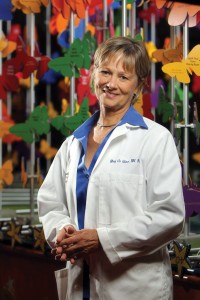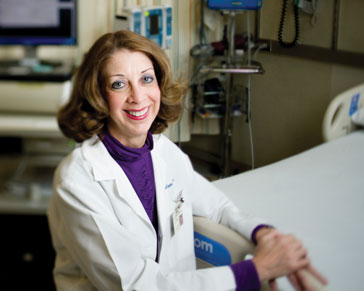Q+A: An Interview with Mary Jo Gilmer
Mary Jo Gilmer, Ph.D., M.B.A., A.P.R.N., is a pioneer in the field of pediatric palliative care, helping establish the palliative care program at Monroe Carell Jr. Children’s Hospital at Vanderbilt, researching ways to improve care for those with life-threatening or life-limiting illnesses, and teaching a new generation of students that there is always some way to help.
How do you define palliative care?
Years ago palliative care’s connotation was end-of-life care. The newer thinking and the World Health Organization’s definition takes a more holistic approach, specifically to assist children and families in fulfilling four dimensions: their physical, psychological, social and spiritual goals in their lives. From the time individuals are diagnosed with life-limiting or life-threatening conditions, they can benefit from palliative care.
How do you handle dealing with a young child or infant versus an older teenager?
There is absolutely a different way to deal with different aged children within the span of 0 to 18 years of age. They have very different understandings of life and death. A young child doesn’t have an adult comprehension of death – as being universal and irreversible and inevitable – until between 6 and 9 years of age depending on their life experiences. And, parents are another important piece. The death of a child is devastating and parents also deal with loss of having a normally developing child such as learning their child was born with a neuromuscular degenerative condition. That type of loss can be equally devastating. Half the children who die are under age 1, before they are really able to express whether they are in pain and what kinds of symptoms they are having. So, it’s up to the parents and health care providers to try to discern what’s going on with the child and comfort them.
What role do siblings play?
One of our current research initiatives is a National Institutes of Health-funded five-year study looking at parent and sibling bereavement after a child dies from cancer. We are trying to learn more about the factors that contribute to better adjustment as parents and siblings grieve. Parents never get over the loss of a child, but some parents are able to incorporate the memories and to adjust more easily than others. The same is true with siblings. Some fall apart, while others become more independent and seem to blossom afterwards. We want to find out what makes the difference so we can help those who don’t adjust very well.
What pathways are there for nurses into palliative care?
Nurses in palliative care can work on many different levels. A bachelor’s-prepared nurse could work as a staff nurse in a hospital on a unit, like oncology, neonatal ICU, or pediatric intensive care unit. A nurse practitioner or clinical nurse specialist might work on a palliative care team to help with pain and symptom management. Nurse practitioners or D.N.P.s can coordinate care for a child who has been admitted to a palliative care service. And for those with a Ph.D., the area of research is wide open because very, very little is known about the needs and the interventions that we can use to improve quality of life.
How does U.S. palliative care compare to other countries?
We can learn a lot from other countries. Great Britain and Scandinavia, in particular, have been experts in palliative care for many years. The first residential hospital in North America was Canuck Place in Vancouver, British Columbia. We now have some residential pediatric hospices in the U.S., but Great Britain was way ahead of us. Even in some tribal areas in Africa, where they don’t have all the technology and they don’t have all of those decisions to make, they provide excellent palliative care, probably better than we do in intensive care units in the U.S. They are not taking someone to get an X-ray every day, they are not tube-feeding them, they are simply keeping them comfortable with family members around in their home setting. That’s one thing we strive for. If a child wants to go home, then we ought to be able to find a way. It’s not always possible, but in rural Uganda, that’s the only choice they have.
What are some of the biggest controversies in this field?
One of our difficulties is that health care providers may not always agree. We all passionately want what is best for the child, but often we don’t agree on how to achieve that. That’s especially difficult for families who look to health care providers to make recommendations. Another big question is how much technology to use. We can prolong life, but just because we can, should we? If it’s not a good quality of life, it seems to me that very few of us would want our lives lengthened. I think what’s really hard in pediatrics is that it’s just wrong for a child to die.
How much do you tell a child who is diagnosed with cancer, for instance?
We think we should be open and honest with children. But do you tell a 5-year-old when they are diagnosed with cancer that they are going to get chemotherapy? That it’s going to make them sick, make their hair fall out and make them tired all the time? Or, do you wait until they begin to experience some of that and explain to them that’s from the medication? We are involved in another study to learn these and other answers about communication needs based on age, gender and prognosis as well. The study involves videotaping parents and recently diagnosed children and comparing what they say and how they interact with their scores on adjustment measures.
How do we measure the success of palliative care?
We implemented a palliative care program in Children’s Hospital five years ago. At that time, we got baseline data from chart reviews of the children who died – documentation of pain management, referrals to hospice or pastoral care or social workers or psychologists, and do not resuscitate orders. We also conducted parent satisfaction interviews six months after a child died. We are doing a follow-up study to see if there are differences in the pain management, referrals and parent satisfaction. So much is based on perception, and it will be interesting to see if parents feel that they were listened to. If they perceive that the pain wasn’t managed well, we have to go back to the drawing board.
Is it hard for you to say goodbye?
I do say goodbye to the child, but I don’t always say goodbye to the family. Many times the family continues to work with us and members of the team. If a family has the kind of support system that will nurture them, then it’s not difficult to say goodbye. But if a family is having trouble, then it’s hard to say goodbye until we know they have what they need.
How do you cope with all the dying you see?
I don’t feel that I really need to do anything special to cope. What feeds me, what nourishes me, is being with families. They give much more than I’m able to give. The bottom line is the families help me.
Do you feel like palliative care is gaining greater awareness?
Yes, there is an initiative with National Institutes of Health for research specifically in the area of symptom management and palliative care. We are finally acknowledging that death is a part of life. Just like you can have a birth plan – moms decide what kind of birth experience they want – we can have a death plan too – so that families plan where they want to be, what kind of music they want playing, which quilt they want, so there can be a good death. It sounds like an oxymoron, but it’s not. Death is a life transition just like birth, adolescence and marriage.








